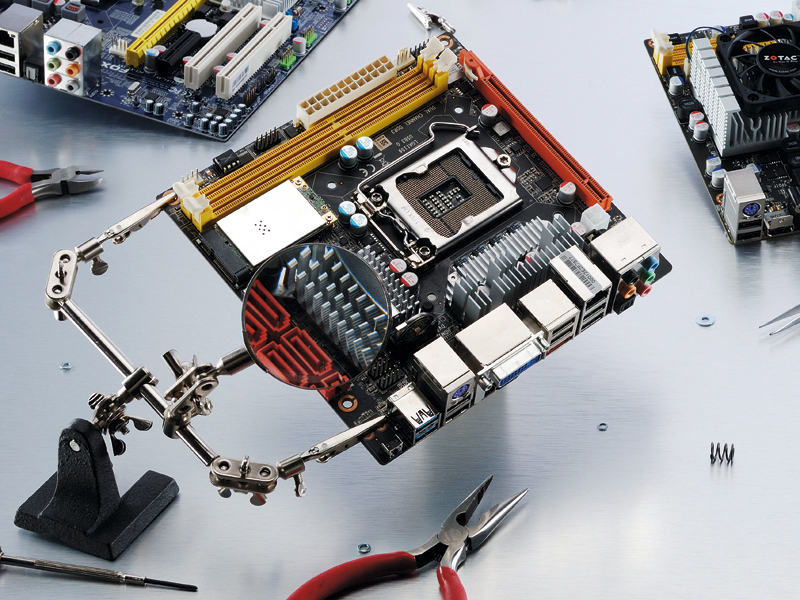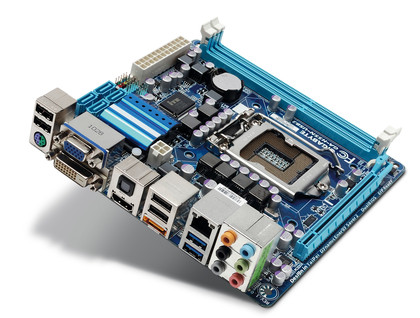8 best micro ATX and Mini-ITX motherboards
The latest small form factor boards pack a big punch

Big power in a small box. It's a seductive idea that's driven sales of small-form factor (SFF) PCs for centuries. Well, it has done for at least the last decade or so. Shuttle, for instance, does a brisk trade in barebones rigs that promise the performance of a full ATX tower in something the size of a two-slice toaster.
The only problem, of course, is that you'll pay handsomely for the privilege. A high performance Shuttle case typically costs around £300.
That's before you drop in a CPU, some RAM, a graphics card and storage. A normal ATX tower with motherboard and PSU can be had for as little as half the cost. Unless, that is, you take a hands-on approach and build a SFF system from scratch.
Small-form factor motherboards, such as microATX and Mini-ITX boards can often be cheaper than full-feature ATX models with the same chipset. Meanwhile, compatible cases are not as expensive as you might think.
Using a smaller board inside a standard ATX case can also make for a simpler, cooler running and easier to manage setup. All of which just leaves the minor matters of performance and features. Surely there must be downsides to downsizing?
Perhaps, but the drawbacks may be less acute than you imagine. The big issue here is increased feature integration in the latest CPUs. Put simply, with more and more features from memory controllers to graphics cores being integrated into the CPU, motherboards are becoming gradually less critical to performance.
Every feature that moves onto the processor is one less component on the motherboard, freeing up space and reducing complexity and cost. In other words, squeezing a full feature set into smaller boards is only getting easier.
Sign up for breaking news, reviews, opinion, top tech deals, and more.
Of course, there are limits. Mini-ITX motherboards, in particular, tend to be thin on features and expansion options. Multi-card graphics solutions, for instance, are not an option. There are also question marks regarding outright performance and overclocking headroom.
Smaller motherboard dimensions give the manufacturer's engineers fewer options in terms of electrical layout and in turn current management and signal integrity. Ultimately, a full ATX board is always going to be the best option for any self-respecting extreme overclocking enthusiast and absolute performance nutcase.
For everyone else, however, small-form factor is probably the future. If we've sold you on the big idea of going small, your first task is getting to grips with the different motherboard form factors.
For the record, the ATX standard officially measures 305mm by 244mm while the larger extended ATX or EATX form factor weighs in at 305mm by 330mm. The two most common SFF sizes are microATX and Mini-ITX. Standard MicroATX boards are 244mm by 244mm but can be as small as 171mm by 171mm.

GIGABYTE H55N-USB3: Astonishingly good H55 board. A high-end performer in a tiny package
In practice few microATX boards diverge from the larger format, effectively making them an ATX board with the section furthest from the CPU socket sliced off. If you're familiar with normal ATX boards, you'll know the amputated area typically houses expansion slots in the form of PCI and PCI Express ports. Normally, therefore, microATX boards offer less flexibility when it comes to catering for add-in boards.
Inevitably there will be fewer PCI and PCI Express slots. However, that doesn't mean you have to compromise performance. Any decent microATX board will have at least one 16-lane PCI Express graphics port and a full-on desktop CPU socket. Some, such as Asus's Rampage III Gene, have a pair of 16-lane ports enabling high performance multi-GPU graphics solutions.
Elsewhere, you'll be forced to make few if any compromises with a microATX board. There's absolutely no reason why it shouldn't have decent chipset cooling, plenty of USB headers and SATA ports as well as a pukka BIOS menu with a full set of overclocking options.
Likewise, a well designed microATX mobo should have ample space around the CPU socket for fitting high performance cooling kit and also provide at least two DIMM slots per channel for the system memory. Just like a standard ATX board, in other words.
That's not, however, something you can say about the Mini-ITX standard. Sometimes known simply as ITX, the definition is a clearer than microATX with fixed measurements of 170mm by 170mm. That, if you hadn't already realised, is ridiculously small for a desktop motherboard and means some features are inevitably for the chop because of it.
Most obviously, system expansion options with Mini-ITX boards are a bit borked. Typically, you'll find a single PCI Express 16-lane slot is your lot. There simply isn't any space for further PCI Express or PCI ports.
Another area where limited space causes a crunch involves the DIMM slots. One per channel is the maximum, which can make it trickier to implement upgrades or make the most of old memory you have lying around. Other features that typically get the chop compared with larger boards are SATA ports and USB headers. You'll have some, just not as many as you're used to.
Then there's the BIOS menu. Mini-ITX boards are often aimed at the embedded or industrial markets. Think information kiosks, factory control units and the like. Not, in other words, applications where cranking up the clockspeed or running ultra-fast RAID arrays is a high priority. Overclocking and other fine tuning options can therefore be overlooked.
That said, it's worth noting that Mini-ITX boards normally do not require specialist components. With a few exceptions, off-the-shelf memory, graphics cards and CPUs are usually fully compatible.
However, what you probably won't be able to bolt on is a high performance cooler for the CPU. At least, you won't be able to fit both a fat cooler and a beefy graphics card at the same time. With space at a premium, the CPU socket on Mini-ITX boards is often too close to the PCI Express graphics port to allow both a discrete video card and a large aftermarket heat sink for the CPU.
One final area where Mini-ITX boards sometimes skimp in the name of space is sound: Full 6.1-plus connectivity may not be present. That said, if you're really serious about sound, you'll prefer to use the S/PDIF interface that some motherboards provide.
Current page: Marvellous mini mobos: Overview
Next Page Marvellous mini mobos: Chipsets and SocketsTechnology and cars. Increasingly the twain shall meet. Which is handy, because Jeremy (Twitter) is addicted to both. Long-time tech journalist, former editor of iCar magazine and incumbent car guru for T3 magazine, Jeremy reckons in-car technology is about to go thermonuclear. No, not exploding cars. That would be silly. And dangerous. But rather an explosive period of unprecedented innovation. Enjoy the ride.